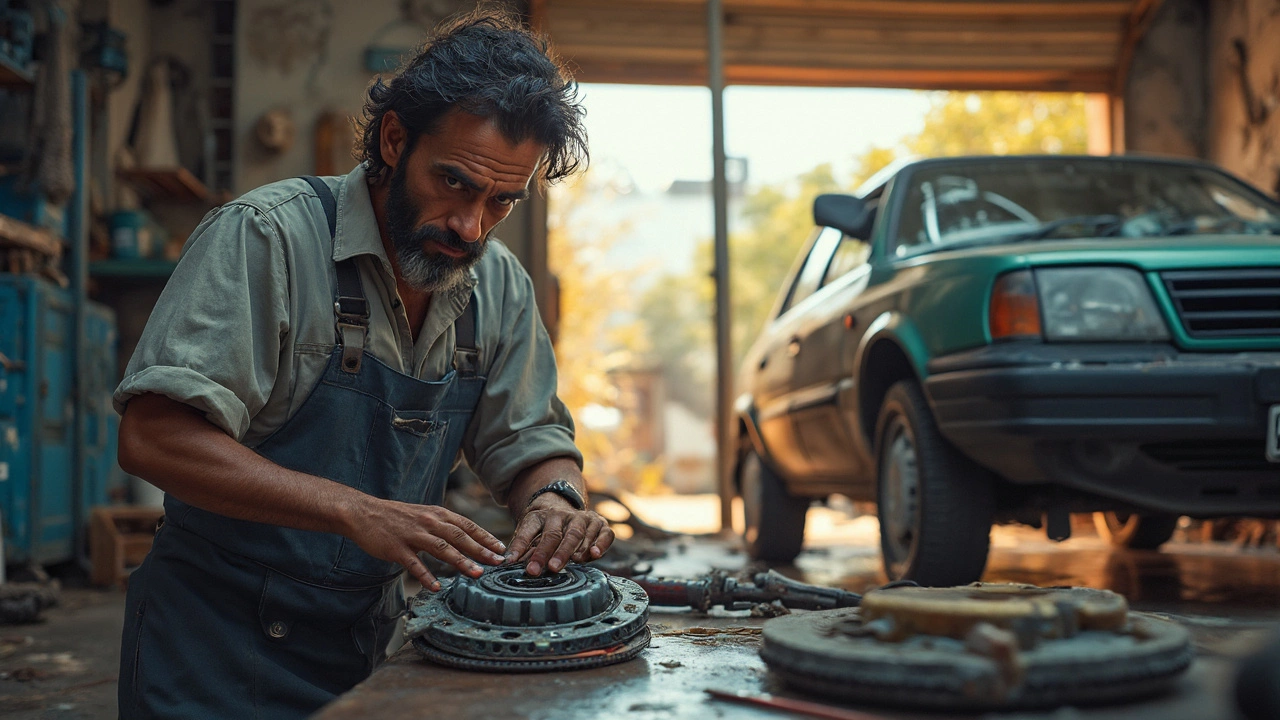 May, 13 2025
May, 13 2025
Your car starts to rev, but you're barely moving. Might feel like the tires are spinning, but it’s not that — your clutch is slipping. It’s a classic problem in manual transmissions, and for a lot of drivers, this is the moment you start sweating about repair bills and downtime.
Before you empty your wallet or grab a wrench, you need to know if the fix is as simple as an adjustment, or if you’re in for a full clutch replacement. I’ll get into how to spot real clutch slip, what actually causes it, and why some fixes are quick while others are almost a weekend project.
Not every slipping clutch is doomed — sometimes, it’s just an issue with the cable or the fluid. But ignore it for too long, and you’re looking at worn parts that only a new clutch kit will solve. Some modern cars throw in more headaches, with hydraulic systems and tighter spaces. I’m going to break it all down so you know what you’re really dealing with and if you should even bother popping the hood yourself.
- How to Tell if Your Clutch Is Slipping
- What Actually Causes a Clutch to Slip?
- How Difficult Is a Clutch Fix?
- When to Try DIY and When to Call a Pro
How to Tell if Your Clutch Is Slipping
If you’ve got a manual car and something feels off, here’s how you figure out if your clutch is slipping. Spotting these signs early can save you from much bigger headaches down the road.
First thing to notice: is your engine revving higher than usual but your car doesn’t pick up speed like it should? This is classic slipping clutch behavior. It almost feels like you’re driving with the clutch pedal half-pressed even though your foot is off it.
- Slipping clutch symptoms usually show up strongly in higher gears—especially third and up. Try accelerating on a flat road in fourth gear. If the RPM shoots up but your speed barely moves, you’ve probably got a slipping clutch.
- Another big sign: your clutch pedal feels different. Sometimes it gets really light or loose. Other times, it grabs way too high off the floor.
- Burning smell? That’s another big giveaway. When a clutch slips, it generates more heat, and this can smell like burning rubber or overheated brakes.
- If you get sudden loss of power whenever you try to overtake or go uphill, don’t ignore it. You’re not imagining things—this is how clutches signal trouble.
The best DIY test? Park somewhere safe, put your car in second or third gear, and try to accelerate hard while letting the clutch out quickly. If the engine revs go up but your car doesn’t move like it should, that’s a clear sign.
Even one of these signs points to clutch slip, but more than one? Time to plan your next step before it turns into something way more expensive.
What Actually Causes a Clutch to Slip?
So, why does a clutch start slipping in the first place? It’s all about friction—when you press on the clutch pedal, plates inside the clutch kit separate just enough to let you shift gears. When those plates can’t grip each other tightly anymore, power doesn’t make it from your engine to the wheels like it should. That’s a slipping clutch in action.
The most common culprit is plain old wear and tear. Clutch discs are made to slowly wear down, just like brake pads. If you’re stuck in traffic a lot, ride the clutch pedal, or haul heavy loads, your clutch will go quicker. But it’s not just about old age. Oil leaks from the engine or transmission can drip onto the clutch and ruin its grip. Sometimes, the problem is with the clutch cable or hydraulics not letting the clutch plate fully engage.
- Worn clutch disc: The disc surface loses friction material over time, making it slippery.
- Oil contamination: Bad seals mean oil leaks onto the clutch. A little oil makes it slip a lot.
- Weak or broken pressure plate springs: These springs push the plate against the disc. If they’re weak, the grip’s gone.
- Bad clutch cable or hydraulic system: If the cable stretches, frays, or a hydraulic system leaks, the clutch might not fully engage—again, more slip.
If you’re curious about how these issues stack up, here’s a quick look at how often each cause pops up when mechanics check for slipping clutches:
| Cause | Approximate Frequency (%) |
|---|---|
| Worn clutch disc | 60 |
| Oil contamination | 20 |
| Weak pressure plate | 12 |
| Bad cable/hydraulics | 8 |
Bottom line: wear is the big one, but leaks and broken bits make up a solid chunk of clutch headaches too. If you keep a close eye on any leaks and avoid riding the clutch pedal, you can avoid some of the most common problems that end with a slipping clutch.

How Difficult Is a Clutch Fix?
If you’re wondering if fixing a slipping clutch is a quick job, here’s the reality: it isn’t always “easy,” even for folks who know their way around cars. The real challenge comes down to what’s actually causing the slip and the type of car you drive. If the clutch just needs an adjustment (which is rare on newer cars), it might take less than an hour. If you need to swap out the whole clutch kit, you’re looking at several hours of work—usually around 4 to 8, sometimes even more for front-wheel-drive or all-wheel-drive setups.
You can’t just pop the hood and replace a clutch like you would an air filter. Fixing a clutch usually means dropping the transmission out. That means jack stands, a transmission jack, and real elbow grease. Some cars (like older rear-wheel drives) are a bit friendlier, but plenty of front-wheel-drive cars have cramped engine bays that make every step harder. Expect to remove exhaust parts, axles, driveshafts, and then pry the transmission away from the engine to actually get to the clutch.
Here’s what usually goes into a full clutch replacement:
- Disconnecting the battery and removing the driveshaft or CV axles.
- Unbolting and supporting the transmission.
- Dropping the transmission out of the way.
- Swapping the old clutch, pressure plate, and release bearing for new parts.
- Reinstalling everything and, if needed, bleeding the clutch hydraulic system.
Most shops quote clutch replacements between $700 and $1,400, with parts alone often costing $200-$500. The price shoots up for specialty cars. Some newer vehicles even require removing subframes or using special tools. If you’re not set up with proper tools or experience, it can turn into a real headache fast.
| Car Type | Average DIY Time (hrs) | Typical Shop Price (USD) |
|---|---|---|
| Rear-wheel drive (older) | 4-6 | $700-$900 |
| Front-wheel drive | 6-10 | $900-$1,300 |
| All-wheel drive | 8-14 | $1,100-$1,700 |
If you just need an adjustment or a clutch cable replacement, you might get away with an hour’s work and the cost of a basic part. But the second your repair involves dropping the transmission, even experienced DIYers will feel the burn. For most folks, this isn’t a “Saturday afternoon” job—unless you’ve got a good garage setup and a buddy or two to help out.
When to Try DIY and When to Call a Pro
If you’re wondering whether you can handle a slipping clutch yourself, the answer depends on the exact problem, your tools, and your patience. Some clutch jobs are a piece of cake if you’ve got a basic toolkit and a bit of experience. Others? Not so much—especially on newer cars packed with electronics and cramped engine bays.
Here’s a quick cheat sheet for what jobs you could try yourself, versus the stuff best left to a shop:
- Try DIY if:
- The clutch slip is mild and may be from cable stretch or low hydraulic fluid.
- You have a service manual for your car model.
- You can get the car up on jack stands and safely disconnect the battery.
- You’ve tackled other medium-level car repairs, like changing brakes or a timing belt.
- Call a Pro if:
- The clutch is totally burnt out, and you smell burning or lose all drive.
- Your car has a dual-mass flywheel or other complex clutch setup.
- There's transmission fluid leaking out or you hear weird grinding noises.
- You don’t have a transmission jack, lift, or a solid backup plan if things go sideways.
Why’s it such a big deal? Because replacing a clutch often means pulling out the entire transmission—a job that usually takes 4-8 hours for a pro, sometimes longer for a do-it-yourselfer. To put it in perspective, here’s what you’re up against:
| Task | DIY Time Estimate | Pro Shop Time Estimate | Tools Needed |
|---|---|---|---|
| Clutch cable/hydraulic adjustment | 30-60 mins | 20-30 mins | Wrenches, brake fluid |
| Clutch replacement (front-wheel drive) | 6-10 hours | 4-6 hours | Jack stands, transmission jack, socket set |
| Clutch replacement (rear-wheel drive) | 5-8 hours | 3-4 hours | Jack stands, transmission jack, socket set |
One more thing—clutch kits often cost $150-$400, but a shop might charge $800 or more (parts and labor) for the whole job. If you value your time or if your car is your daily ride, paying for the peace of mind might be worth it. But if you love wrenching and don’t mind a few scraped knuckles, some jobs really are doable on a weekend—just don’t underestimate how heavy that transmission can get.
If you ever get in the middle of the job and realize it's beyond you, don't feel bad. Even seasoned mechanics swear at stubborn clutch bolts. Sometimes it’s just smarter (and safer) to call in someone with a lift and the right experience.